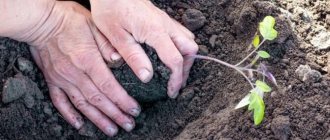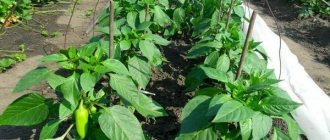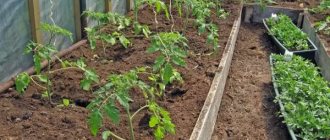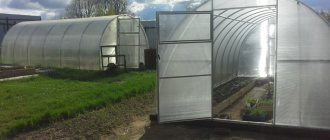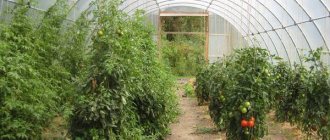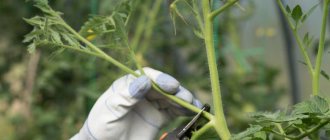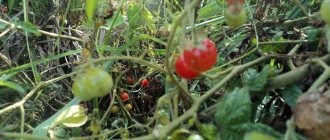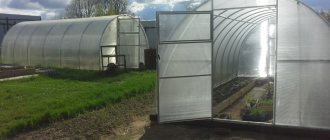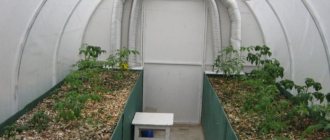Planting tomatoes in a greenhouse has its advantages. Even in an unheated room, the crop ripens two weeks earlier than in open ground. And the yield of greenhouse tomatoes is 2-3 times higher.
Therefore, in order to reap a good harvest of tomatoes grown indoors, you must follow a number of simple rules when planting. Namely, maintain a minimum distance when planting various types of tomatoes in a greenhouse. To save useful space, use diagrams.
What is the danger of thickening plantings in closed ground?
Many gardeners, in order to save usable space and increase productivity by increasing the number of bushes, plant tomatoes in greenhouses thicker than recommended. However, this should not be done, since thickening the plantings can lead to the opposite effect - a lower and later harvest.
To reap a good harvest, you must adhere to some rules when planting. Thickening of the planting is extremely undesirable. This is due to the fact that:
- Tomatoes love brightly lit growing areas. With dense planting, shading of neighboring bushes occurs, which negatively affects the growth and ripening of fruits and the development of the plant itself.
- Each seedling has its own rate of growth and development, and, therefore, one plant’s root system can develop faster than its neighbor’s. If the distances between them are too close, moisture and nutrients are distributed unevenly, which leads to a delay in the growth of one of them.
- When planted densely, difficulties arise with care and harvesting.
- Thickening creates a lack of moisture and nutrition for the tomatoes.
- Plants located close to neighboring ones come into contact with leaves and other parts. This creates a favorable environment for the spread of many diseases and the proliferation of pests.
Seed preparation
Selection, sorting and preparation of tomato seeds for sowing as seedlings is the first stage of growing greenhouse tomatoes. If the seeds were sold without a shell, then they must be prepared by soaking the seeds in a solution of Fitosporin, diluted according to the attached instructions.
After treatment with phytosporin, there is no need to wash the seeds. If possible, you can soak the seeds in one of the commercially available growth stimulants. After treating the seeds with a growth stimulator, the seeds are sown in a nutrient mixture.
The nutritional mixture begins to be prepared from the beginning of February to the end of March. The optimal period for planting tomato seeds for seedlings is February-March. Late varieties of tomatoes are sown earlier, in February; mid-season varieties - in early March; early ripening varieties of tomatoes - at the end of March.
We calculate the required number of bushes per greenhouse area
When planting tomatoes in closed ground, it is necessary to make maximum use of the usable area, taking into account the needs of each variety. And also plant the tomatoes so that you have free access to each bush.
The recommended interval between bushes is at least 35 cm for early varieties and at least 45 cm for middle and late varieties. The distance between rows is 70-80 cm. On average, 1 tomato bush accounts for 0.3 meters of square usable area.
The beds in the greenhouse are placed in the direction from west to east. For a small greenhouse (for example, 3x6 m), two beds are laid out and 1 pass is made, or 3 beds are made with 2 passes. In a small area it is advisable to make longitudinal beds.
Preliminary subtleties
In order to count on a good harvest, it is important to take into account many factors that influence the seedling planting pattern. When purchasing tomato seeds, you need to know exactly for what purpose the tomatoes will be grown. When purchasing tomato seeds, you need to know exactly for what purpose the tomatoes will be grown
When purchasing tomato seeds, you need to know exactly for what purpose the tomatoes will be grown.
- For transportation (for example, for sale), varieties with high shelf life and dense skin are needed so that they do not crack or deteriorate during transportation.
- For fresh use (in salads, juices), the earliest, juicier large-fruited varieties are suitable.
- Late, fleshy, small-fruited varieties are more suitable for canning and pickling.
In addition, the following characteristics are important for greenhouse conditions:
- growing conditions (varieties must be adapted to closed ground conditions);
- taste, meatiness;
- productivity;
- ripening time;
- fruiting period;
- type of bush formation;
- fruit size;
- resistance to diseases.
The seasonality of the greenhouse itself also matters - whether it is unheated or year-round, with heating.
Determining the distance between seedlings of different varieties
Each tomato variety has its own special characteristics, as well as space requirements that you need to know when planting. Depending on the height of the bush, the distance between the seedlings is determined. There are several types of tomatoes: indeterminate, determinate and low-growing.
Indeterminate
Popular among gardeners due to their high yields. But they are not suitable for planting in small and low greenhouses. The main characteristic of the variety is unlimited stem growth. The bush reaches 250-300 cm in height and has 2-3 stems.
Large plant sizes require space and proper care. For this species, it is recommended to leave an interval of 80-90 cm between rows and at least 65 cm between bushes in a row. No more than 2 seedlings are planted per 1 square meter.
Indeterminate varieties include “tomato tree” or “liana”. This variety has unlimited height growth and several strong trunks. Suitable for large greenhouses only. When planting, an ordinary scheme is used. The optimal distance between neighboring bushes is at least 1 meter.
Determinate (medium-sized)
The main characteristic is a stop in the growth of the bush after the formation of the ovary. Determinate tomatoes reach a height of 120-150 cm.
The distance between rows for taller ones is 70-80 cm, for lower ones - from 50 cm. Approximately 40 cm is left between bushes in a row. Up to 4 seedlings can be placed on 1 square meter.
Low-growing, standard
They grow no more than 45 cm. They are characterized by a strong and wide trunk and a small root system. Compared to other varieties, they have lower yields, but are valued for their unpretentiousness and ease of care.
Care
Tomatoes are far from being the most demanding vegetables, but they also need proper care. Here are 6 rules that will help you achieve a rich harvest:
1. The air temperature inside the greenhouse should be 23-26°C. Check the greenhouse covering for cracks and tears, and also insulate the walls with a layer of oilcloth;
2. After planting, stop watering for 10 days so that the plant can take root. For irrigation, use water at a temperature of 20-22°C. Until the tomatoes bloom, watering is carried out every 4-5 days, and for one square meter you will need approximately 4-5 liters of water, after flowering - 12-13. You need to water at the root and do it better in the morning, since by evening condensation will appear on the walls of the greenhouse and drip onto the leaves.
Watering can be done “classically”: from a hose and watering can or using automatic irrigation systems:
- Intrasoil - pipes are laid 30 cm underground, irrigate directly the root system;
- Sprinkler - the tubes are located on top, there are nozzles that simulate rain;
- Drip - pipes are located on the surface of the soil, water is supplied at certain intervals in small quantities.
Keep in mind that there is no universal watering system for all tomatoes, because each variety has its own characteristics.
3. It is important to maintain humidity at least 60% and no more than 70%. Excess moisture attracts pathogenic bacteria, causes plant rotting and leads to deformation of the fruit.
4. When the seedlings are accepted, for greater confidence we recommend carrying out the first fertilizing. The second should be carried out after the first ovaries appear. Select a complex fertilizer and apply about 400-500 grams per 100 square meters. Time-tested fertilizers are calcium and ammonium nitrate.
5. Ventilate the greenhouse regularly - this will help the tomatoes self-pollinate.
6. Trim excess branches and leaves in a timely manner - thanks to this, beneficial substances will get inside the fruit.
The best planting schemes for tomatoes in a greenhouse
The planting scheme allows you to rationally plant tomatoes in a limited area of the greenhouse while maintaining distances. Different patterns are used for different varieties of tomatoes. When choosing a design, it is important to consider the plant's vigor and characteristics.
Square-nested
This method of landing was widespread back in the Soviet Union. Suitable when using mechanized processing and harvesting methods. The intervals between the rows and bushes in the row are the same and amount to 70 cm.
Seedlings are located in the corners of the square. In order to increase the number of bushes per usable area, not one, but two or three plants are planted at a close distance from each other (nest). Subsequently, the planting is thinned out and non-viable plants are pulled out.
Chess
Suitable for tomatoes that form more than one stem, medium-sized determinate varieties. First, one row is formed. After planting the first one, the second one is planted at a distance of 50-60 cm. It is not recommended to plant both rows at the same time. The seedlings of the second row are located between the seedlings of the first, forming a checkerboard pattern.
Depending on the type and number of stems, the spacing between plants is maintained. For indeterminate varieties, the spacing between rows should be 70 cm. The more shoots a tomato has, the wider the bushes are planted.
Parallel landing
Applicable for all types. It differs from the ordinary one in that the tomatoes are planted in two rows. Each two-row is separated by a passage of 90-100 cm. The distance between the rows is from 40 to 50 cm. The planting interval in the row is 50-70 cm, depending on the type. Another name is “ribbon-cluster” planting. This method is good for planting low-growing species.
The disadvantage of this method is partial shading of the plants.
Also, planting in a parallel pattern takes up a lot of space and is not suitable for small greenhouses. The advantages include convenient access to the plant for care and harvesting, both manually and mechanized.
Harvesting
As mentioned earlier, determinate varieties bear fruit for only a few weeks, while indeterminate varieties bear fruit for up to several months. In both cases, tomatoes are harvested as they ripen, of which there are several:
- Green;
- Dairy;
- Pink;
- Full.
When a tomato turns red, you should pick it as quickly as possible, otherwise it will become overripe, soften and taste worse. It is recommended to collect tomatoes without stalks, and to harvest the bushes when the first frosts begin at night. If some of the fruits are not ripe by this time, then they can be picked: the pink ones will ripen in a warm place, and the green ones can be pickled.
Vegetable growing is not an easy task and requires certain skills, patience and investment. However, there is nothing tastier than tomatoes grown by yourself. We hope this article was useful to you and you found answers to your questions.
Advice from experienced gardeners
- Before you start planting, you need to plan the planting of seedlings. To do this, you will need a measuring tape, ropes and a marker (a piece of wood for marking the future hole).
- Do not make the intervals between seedlings too large. This stimulates the growth of leaves and unnecessary branches.
- The diameter of the hole is up to 20 cm for short types of tomatoes and 30-35 cm for medium-sized and tall ones. Depth 15-20 cm.
- You should not plant tomatoes where peppers or eggplants used to grow. But cabbage and cucumbers will be good predecessors.
- It is not advisable to plant tomatoes and cucumbers together due to different temperature conditions and the greater need for hydration of cucumbers.
- You can place 2-3 seedlings in one hole, but the intervals between holes will have to be increased based on the needs of each plant for sunlight and nutrition.
- Before planting seedlings, the soil in the greenhouse is fertilized with superphosphate.
- Planting tomatoes in a greenhouse should be done on a cloudy, not hot day or in the afternoon in slightly moistened soil. The optimal height of seedlings for planting is 30-35 cm.
- When planting indeterminate tomato species, slight thickening is allowed. In this case, stepsoning and the presence of hanging supports are mandatory.
To obtain a rich harvest, you should follow the recommended standards when planting. In order to save space in the greenhouse and make optimal use of the usable area, you should carefully plan the location of the beds and passages and determine the pattern of planting seedlings.
Maintaining intervals between bushes will allow you to easily approach the plant and create conditions for growth and development for the plant itself.
What planting density is observed?
Planting tomatoes usually begins by creating holes. Their optimal size is determined by the variety of tomato seedlings selected for planting in greenhouse conditions. According to the standards, holes for low-growing varieties should be 20 cm, and for tall varieties - 30 cm. You should start preparing the holes a week before planting.
The soil is warmed up before planting, otherwise the plants can be affected by various diseases, which causes their death. 2 weeks before planting tomato seedlings, the plants are hardened off and simultaneously processed, which allows the plants to be protected. This will need to be done 5 days before disembarkation. Typically, a solution of boric acid is used for this purpose.
The lower leaves of tomato seedlings should be plucked 2 days before planting. Deep planting of seedlings is unacceptable, as they may go to the roots. The placement of plants should be vertical.
Until the seedlings stretch out, they are covered with the treated soil mixture at a level that coincides with the recess in the seedling pot. Adding too much fertilizer causes the bushes to grow too large.
